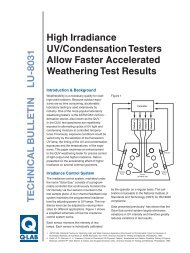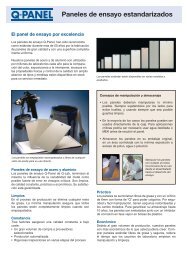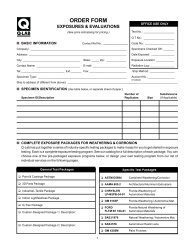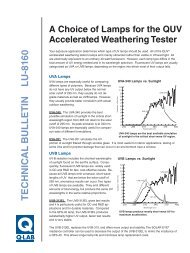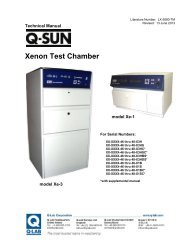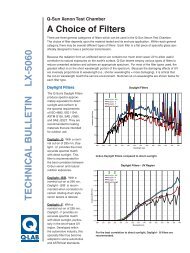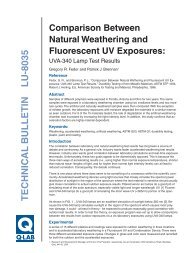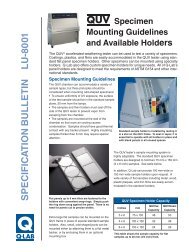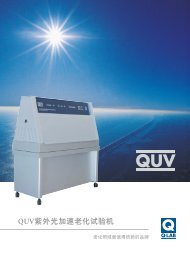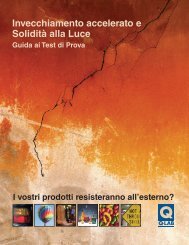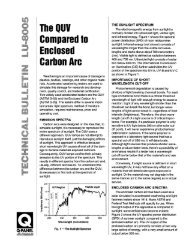Accelerated Corrosion of Paints - Q-Lab
Accelerated Corrosion of Paints - Q-Lab
Accelerated Corrosion of Paints - Q-Lab
Create successful ePaper yourself
Turn your PDF publications into a flip-book with our unique Google optimized e-Paper software.
REPRINT<br />
May 1991<br />
<strong>Accelerated</strong> <strong>Corrosion</strong><br />
Testing <strong>of</strong><br />
Industrial Maintenance<br />
<strong>Paints</strong> Using A<br />
Cyclic <strong>Corrosion</strong><br />
Weathering Method<br />
by C.H. Simpson, C.J. Ray, and B.S. Skerry<br />
The Sherwin- Williams Co.
<strong>Accelerated</strong><br />
<strong>Corrosion</strong> Testing<br />
<strong>of</strong> Industrial<br />
Maintenance<br />
<strong>Paints</strong> Using A<br />
Cyclic <strong>Corrosion</strong><br />
Weathering Method<br />
by<br />
C.H. Simpson,<br />
C.J. Ray, and<br />
B.S. Skerry<br />
The Sheuwin-<br />
Williams Co.<br />
I t is widely accepted that improved<br />
methods for assessing the corrosion<br />
controlling properties<br />
<strong>of</strong> organic coatings on steel are<br />
needed. Difficulties ~- -. with established testing<br />
procedures (primarily ASTM B 117 salt spgy) have<br />
been well documented]-3 and need not be<br />
restated here. As pointed out in a recent review,4<br />
the need for reliable short-term testing procedures<br />
is greater than ever considering the extensive<br />
formulation changes in established coating systems<br />
that are expected to result from increasingly<br />
stringent volatile organic content (VOC)<br />
regulations. More realistic testing procedures<br />
will allow meaningful performance comparisons<br />
between old and new VOC-compliant compositions<br />
without reliance on long-term exterior<br />
exposure results.<br />
The most crucial requirements <strong>of</strong> a "good"<br />
or meaningful laboratory test are that it simulates<br />
the relative performance rankings <strong>of</strong> materials observed<br />
in practice and that it produces failure<br />
modes consistent with field experience. Additionally,<br />
a useful test must be reproducible and reasonably<br />
rapid. No currently available tests have been<br />
shown to meet these requirements.5<br />
Although it would not seem practical (or<br />
even possible) to simulate, completely, the numerous<br />
and complex variables operating in the outdoor<br />
environment, a reasonable approach would<br />
Journal <strong>of</strong> Protective Coatings 6 Linings
<strong>Accelerated</strong> Testing <strong>of</strong> Maintenance Coatings<br />
(b) alkydalkyd<br />
(c) latefiatex<br />
Fig. 1 Scribed regions <strong>of</strong>panek atler2,OOO hours'$alt spmy testing (1,000 hours for lalex)<br />
(a) epoxylepoxy<br />
(b) alkydalkyd<br />
Fig. 2 Scribed regions <strong>of</strong> panels after cyclic wetldry corrosion fesling (2,000 hours)<br />
involve identifying the most significant <strong>of</strong> these<br />
variables and incorporating them into an accelerated<br />
testing protocol. In recent years, claims <strong>of</strong> improved<br />
correlations with exterior results have been<br />
reported based on the use <strong>of</strong> cyclic wetldry corrosion<br />
chambers6Jl8 (i.e, chambers producing periods<br />
<strong>of</strong> salt fog alternating with periods when test<br />
samples are allowed to dry). This cyclic wetting<br />
and drying <strong>of</strong> electrolyte layers from the panel surface<br />
is thought to stress the coating in a more realistic<br />
manner than, for example, a continuous<br />
ASTM B 117 salt spray test, where panels are<br />
placed in a constant, high relative humidity (RH)<br />
environment (-97 percent). At the very least, incorporation<br />
<strong>of</strong> wetldry cycling factors seems intuitively<br />
justified, considering that materials exposed<br />
to the outdoor environment undergo similar wetting<br />
and drying effects on a frequent basis. The importance<br />
<strong>of</strong> electrolyte composition has also been<br />
addressed (e.g., the incorporation <strong>of</strong> ammonium<br />
and sulphate species to simulate corrosion processes<br />
occurring in industrial environmentsl~6).<br />
Although there has been increased recognition<br />
<strong>of</strong> the importance <strong>of</strong> wetidry cycling (or cyclic<br />
stress factors in generalg) and electrolyte composition<br />
variables, little attention has been given to the<br />
influence <strong>of</strong> weathering factors (e.g., ultraviolet<br />
light exposure, moisture condensation) in the<br />
overall paint degradation and corrosion process.<br />
Because corrosion at the paint/metal interface and<br />
weathering <strong>of</strong> paint films are processes occurring<br />
simultaneously in nature, it does not seem unreasonable<br />
to suggest that the 2 processes may be significantly<br />
interrelated. For example, weather-induced<br />
degradation <strong>of</strong> a paint's organic binder may<br />
result in a more hydrophilic coating surface, which<br />
could change the time-<strong>of</strong>-wetness and subsequent<br />
corrosion characteristics <strong>of</strong> the system.<br />
Other effects may include the following:<br />
enhanced retention <strong>of</strong> surface contamination<br />
and transport <strong>of</strong> detrimental species through the<br />
weather-damaged coating;<br />
changes in physical properties <strong>of</strong> the paint, such<br />
as elasticity, which may have an impact on subsequent<br />
performance characteristics; and<br />
possible dilution <strong>of</strong> surface species and other effects<br />
associated with the deposition <strong>of</strong> relatively<br />
"clean" water on the painted surface during periods<br />
<strong>of</strong> rainfall or condensation.<br />
In an earlier paperlo, the significance <strong>of</strong><br />
combining weathering and corrosion cycles into a<br />
single test method was investigated. The results indicated<br />
that the corrosion performance characteristics<br />
<strong>of</strong> organic paint films were markedly affected
<strong>Accelerated</strong> Testing <strong>of</strong> Maintenance Coatings<br />
(a) epoxylepoxy (b) alkydlalkyd (c) latexllatex<br />
Fig. 3 Scribed regions <strong>of</strong> panels aller combined corrosionlweathering testing (2,000 hours)<br />
(b) alkydlalkyd<br />
Fig. 4 Scribedregions orpanels affer 27months1marine exposure (21 months for latex)<br />
by the ultraviolet light-weathering factors in the<br />
test. The purpose <strong>of</strong> this paper has been to compare<br />
results obtained from a combined cyclic corrosiodweathering<br />
test method with data obtained<br />
from outdoor exposures. Further comparisons with<br />
data from ASTM B 117 salt spray and wetidry corrosion<br />
cycling (in the absence <strong>of</strong> the weathering<br />
factors) have also been made.<br />
Experimental Design<br />
Coating Systems<br />
Three commercial quality, industrial maintenance<br />
coating systems (i.e., primers with appropriate topcoats),<br />
representing important generic coating<br />
types (catalyzed epoxy-polyamide, acrylic latex, and<br />
alkyd), were studied. Further details for these coating<br />
systems are shown in Table 1.<br />
All coatings were applied to grit-blasted,<br />
3 in. by 6 in. (8 cm by 16 cm) cold rolled steel<br />
test panels (washed and degreased) using an<br />
automated air spray technique. Primers were<br />
allowed to cure 24 hours before topcoating.<br />
Topcoated panels were allowed to cure for<br />
1 full week before testing. The lower half <strong>of</strong> each<br />
coated panel was scribed with an X through<br />
the coating down to the metal substrate. (Panels<br />
exposed at the marine site were scribed with a<br />
single straight line, running vertically along the<br />
panels.) In all cases, panels were exposed in<br />
duplicate pairs.<br />
<strong>Accelerated</strong> Testing Procedures<br />
Three accelerated tests were studied:<br />
standard ASTM B 117 salt spray,<br />
cyclic wettdry corrosion testing using a dilute<br />
(NH4)2S04/NaC1-based electrolyte, and<br />
the cyclic wetldry corrosion test (as above) with<br />
weathering factors incorporated (i.e., a combined<br />
corrosiodweathering test).<br />
Table 2 outlines the important features <strong>of</strong><br />
these testing procedures. A more detailed description<br />
<strong>of</strong> each technique is given below. Coating systems<br />
were tested for 2,000 hours in each accelerated<br />
exposure environment.<br />
Salt Sprag (ASTM B 11 7-85)<br />
Panels were exposed, at a 15- to 30-degree angle<br />
Journal <strong>of</strong> Protective Coatings & Linings<br />
3
<strong>Accelerated</strong> Testing <strong>of</strong> Maintenance Coatings<br />
Table 1 Coating Systems Studied<br />
Total DFT<br />
Primer Topcoat Substrate mils (microns)<br />
(barium metaborate<br />
inhibitor)<br />
(cold-rolled, 1.5- to 2.0-mil<br />
Table 2 Salient Features <strong>of</strong> Test Methods Studied<br />
Test 'b~e Features<br />
Wetidry test** Cyclic stress I-hour 0.35 (wt) percent (NH4)2S04,0.05 (wt)<br />
percent NaCl spray at ambient temperature;<br />
I-hour dry at 35 C, purged with air;<br />
*PBTASTM B 117<br />
**WeUdrpFmhesion~ Mebon <strong>Paints</strong>, UUd)<br />
w*Com'~eat~W cabinet (@Panel Cornpang)<br />
from the vertical, to continuous deposition <strong>of</strong> a ing with one-hour periods with no spray and eleneutral<br />
5 (wt) percent NaCl solution at elevated vated temperature (35 C). The electrolyte used in<br />
temperature (35 C) and high humidity (approxi- this work was a 0.35 (wt) percent (NH4)2S04, 0.05<br />
mately 97 percent RH).<br />
(wt) percent NaCl solution having a slightly acidic<br />
pH (-5.2) upon atomization. Electrolyte was<br />
WetIDuy (Mixed Salt) <strong>Corrosion</strong> Test<br />
atomized at an approximate rate <strong>of</strong> 600 mhour<br />
Panels were exposed to one-hour periods <strong>of</strong> salt into a 0.33 m3 testing chamber. Panels were exspray<br />
(mixed salt) at ambient temperature alternat- posed at a 15- to 30-degree angle from the vertical
<strong>Accelerated</strong> Testing <strong>of</strong> Maintenance Coatings<br />
Performance Ratings* <strong>of</strong><br />
lhble 3 Coating Systems After Testing<br />
Test Method Conditions Rated Alkyd System Latex System Epoxy System<br />
Cyclic wetldry Blistering (size, frequency) 10110 10110 10110<br />
corrosion test Rust-through 10 10 10<br />
(2,000 hours) Undercutting 7 7 7<br />
Overall 37 37 37<br />
marine site Rust-through 10 10 10<br />
(27 months) Undercutting 5 7 0<br />
Overall 35 37 30<br />
Ratingsyslem described in results section<br />
on shelves attached to the inside walls <strong>of</strong> the testing<br />
chamber. By this arrangement, the panels were<br />
positioned in close proximity to resistive heaters<br />
that were located in the chamber walls. The resistive<br />
heaters were activated during drying periods,<br />
thus evaporating the electrolyte layers from the<br />
panel. surfaces. During these dry periods, the cabinet<br />
was also purged with air at a regulated flow<br />
rate. This cyclic wet/dry testing procedure is essentially<br />
that developed by Timmons in the 1970s.6<br />
Chambers designed for carrying out this test are<br />
commercially available.<br />
Cyclic <strong>Corrosion</strong>/<br />
Weathering Test<br />
Panels were exposed to 200-hour periods <strong>of</strong> wet/dry<br />
corrosion cycling (as described above) followed by<br />
200-hour periods <strong>of</strong> ultraviolet light condensation<br />
exposure for a total <strong>of</strong> 2,000 hours (i.e., 5 complete<br />
wet/dry/ultraviolet light condensation cycles). For<br />
the weathering component <strong>of</strong> this test, a standard<br />
ultraviolet light condensation cabinet, conforming<br />
to the ASTM G 53 standard, was employed. Here, a<br />
four-hour ultraviolet light exposure period, using<br />
WA-340 bulbs, at 60 C, was cycled with a fourhour<br />
condensation period at 50 C.<br />
Outdoor Exposure Sites<br />
Marine Site<br />
Panels were exposed for up to 27 months at a 45-<br />
degree angle from the vertical, facing east at a testing<br />
site located on the eastern shore <strong>of</strong> Florida<br />
(Ponce Inlet).<br />
Industrial Site<br />
Panels were exposed for 12 months at a 45-degree<br />
angle from the vertical, facing south, on the ro<strong>of</strong>top<br />
<strong>of</strong> our company's technical center in downtown<br />
Cleveland, OH. The conditions at this site are corrosive,<br />
based on weight-loss measurements made<br />
on bare steel samples (e.g., removal rates [short<br />
term] greater than 50 micrometerslyear for mild<br />
steel are typical).<br />
Journal <strong>of</strong> Protective Coatings 6 Linings
<strong>Accelerated</strong> Testing <strong>of</strong> Maintenance Coatings<br />
Results<br />
The rankings predicted by the combined<br />
corrosion/weathering tests were found to be most<br />
Almost without exception, all failures observed<br />
consistent with those observed in the field. In conafter<br />
testing (accelerated and natural) were associ- trast, the salt spray test predicted precisely the opated<br />
with corrosion and delamination effects along<br />
posite ranking observed in practice. No clear differthe<br />
panel scribes. Figs. 1-4 illustrate the appearentiation<br />
<strong>of</strong> performance was possible using data<br />
ance <strong>of</strong> the scribed regions <strong>of</strong> the coated panels<br />
from the wetldry corrosion test.<br />
after salt spray, cyclic wetldry corrosion, combined<br />
corrosion/weathering, and marine site exposure<br />
tests, respectively. The epoxylepoxy system was the<br />
only material showing any signs <strong>of</strong> degradation<br />
after 12 monthsJ exposure in an industrial atmo- Rankings predicted<br />
sphere. This degradation is illustrated in Fig. 5.<br />
Table 3 shows the average ASTM blister (D<br />
714), rust-through (D 610)~ and undercutting (D<br />
by the combined<br />
1654) ratings assigned to the coating systems after<br />
2,000 hours <strong>of</strong> accelerated testing and after field COITOS~O~/W~~ thering<br />
testing at the marine and industrial sites. In these<br />
rating systems, "10" indicates perfect performance, tests were<br />
and "0" indicates total failure.<br />
Also reported in Table 3 is an overall perfor- most consistent<br />
mance index, calculated by summing the individual<br />
ratings for blister size, blister frequency, under- with rankings<br />
cutting, and rust-through. (The descriptive ratings<br />
suggested by ASTM for blister frequency were conin<br />
the field.<br />
verted to numeric ratings as follows: none=lO,<br />
few=7.5, medium=5, medium-dense=2.5, and<br />
dense=O.) The best possible overall rating - was<br />
therefore 40.<br />
The overall performance values were<br />
Importantly, these rankings, derived from<br />
the data in Table 3, were consistent with the overthen<br />
used t' rank the performance <strong>of</strong> the<br />
coating systems (on a test-by-test basis), as shown<br />
all visual appearance <strong>of</strong> the coatings after testing,<br />
in Table 4.<br />
as illustrated in Figs.<br />
Discussion<br />
Rank Correlations<br />
From Table 4, several important points may be<br />
observed.<br />
Each laboratory test method produced a<br />
unique ranking <strong>of</strong> materials. This suggests that the<br />
differences between these test methods (i.e, continuous<br />
NaCl salt spray, wetldry (NH4)2S04/NaCI salt<br />
spray, and wetldry (NH4)2S04/NaC1 salt spray with<br />
incorporation <strong>of</strong> weathering factors) cause quite<br />
distinct variations in the corrosion protection and<br />
degradation characteristics <strong>of</strong> these organic coatings.<br />
The rankings observed at the marine and industrial<br />
field sites were similar, in that the<br />
epoxylepoxy panels exhibited the most severe<br />
degradation at both sites.<br />
Modes <strong>of</strong> Degradation<br />
All samples exposed at the marine site were found<br />
to undergo blister formation in areas adjacent to<br />
the panel scribes. These blisters were stable (i.e.,<br />
did not collapse upon storage or upon application<br />
<strong>of</strong> finger pressure), were rust-filled, and were<br />
stained orange-brown by the run-<strong>of</strong>f from adjacent<br />
corrosion products. In some cases, the scribe line<br />
underwent a general lifting due to the accumulation<br />
<strong>of</strong> solid corrosion products visible within.<br />
These results are illustrated in Figs. 4(a)-(c). A<br />
similar type <strong>of</strong> scribe line lifting and delamination<br />
associated with nearby blisters was also observed<br />
on the epoxylepoxy system after 1 year at the industrial<br />
atmospheric test site, as illustrated in Fig.<br />
5. Although a very slight tendency to produce filiform<br />
corrosion was observed on the latextlatex<br />
sample after marine site exposure (Fig. 4(c)), this<br />
was not generally found to be a significant mode <strong>of</strong><br />
failure in the natural exposure environments.<br />
The modes <strong>of</strong> degradation observed at the
<strong>Accelerated</strong> Testing <strong>of</strong> Maintenance Coatings<br />
Wle 4 Rank Correlations<br />
Table 5<br />
Exposure Condition<br />
WeWdry corrosion test<br />
Exterior (marine)<br />
terior (ifidustrial)<br />
-<br />
Ranking Observed<br />
(best to worst)<br />
Alkyd=latex=epoxy<br />
Latex>alkyd>epoxy<br />
Latex=alkydrepox<br />
Performance Ratings* <strong>of</strong><br />
Latex Coatings After<br />
1,200 Hours<br />
Cowosion/Weathering Test<br />
Blistering<br />
Coating<br />
(size1<br />
frequency)<br />
Rust-<br />
Through Undercutting<br />
B 10110 6 8<br />
D loll0 4.5 7<br />
*Rating system descdbed in resulls section<br />
marine field sites were generally quite similar to<br />
those observed after testing using the combined<br />
corrosion/weathering test (Fig. 3). This was apparent,<br />
particularly when comparing the marine site<br />
exposures with equivalent panels after 2,000 hours<br />
<strong>of</strong> corrosionhveathering testing. For example, with<br />
the epoxylepoxy system, both field and laboratory<br />
samples exhibit relatively large (greater than 1 cm<br />
in diameter), low-pr<strong>of</strong>iled, rust-filled blisters<br />
'<br />
("scabs") along the scribes. (Compare Fig. 3(a)<br />
with 4(a).) Further, a comparison <strong>of</strong> the performance<br />
<strong>of</strong> the latexflatex system after marine exposure<br />
and after corrosion/weathering testing shows<br />
that both samples exhibit only very small rustfilled<br />
blisters (less than or equal to 2 mm in diameter),<br />
negligible loss <strong>of</strong> adhesion, and only slight<br />
rust-staining immediately adjacent to the scribe.<br />
(Compare Fig. 3(c) with 4(c).)<br />
Neither the salt spray test nor the cyclic<br />
wet/dry corrosion test (Figs. 1 and 2, respectively)<br />
was particularly successful in reproducing the<br />
types <strong>of</strong> failures observed after field testing. The<br />
wet/dry corrosion test produced some lifting <strong>of</strong> the<br />
coating along the scribe and had a clear tendency<br />
to produce filiform corrosion (e.g. Fig. 2(c)). The<br />
formation <strong>of</strong> filiform-type corrosion failures in this<br />
cyclic wet/dry corrosion environment is consistent<br />
with the findings <strong>of</strong> other workers798 Exposure in<br />
the salt spray chamber generally resulted in an accumulation<br />
<strong>of</strong> loosely adherent corrosion products<br />
covering the scribe and, for the latedatex system,<br />
produced a particularly severe (and unrealistic)<br />
breakdown <strong>of</strong> the coating through the formation <strong>of</strong><br />
blisters over the entire panel within 1,000 hours <strong>of</strong><br />
testing. These blisters were <strong>of</strong> a different nature<br />
than those formed along the scribes during exterior<br />
exposure and during corrosion/weathering tests.<br />
In the salt spray test, the blisters tended to be<br />
more hemispherical (i.e., had greater pr<strong>of</strong>ile) and<br />
were not filled with solid corrosion products, as<br />
was observed after field testing, but were <strong>of</strong>ten<br />
filled with liquid electrolyte. The formation <strong>of</strong> rustfilled<br />
blisters around scribed regions <strong>of</strong> the coatings<br />
was not significant in either the salt spray or<br />
the wetldry cycle test.<br />
Based on the relatively good performance <strong>of</strong><br />
the latex system after field exposure, Besalt spray<br />
test would appear particularly misleading in the<br />
evaluation <strong>of</strong> these water-borne systems. As a point<br />
<strong>of</strong> interest, the poor salt spray resistance <strong>of</strong> latex<br />
coatings may, to some extent, account for the general<br />
reluctance to specify such water-borne paints<br />
for service in corrosive atmospheres. The high performance<br />
capabilities <strong>of</strong> these water-borne systems,<br />
however, are increasingly being recognized311<br />
This further demonstrates the need for realistic<br />
and meaningful laboratory testing procedures.<br />
Evaluation <strong>of</strong> Closely Formulated Coatings<br />
Clearly, from the results above, the most meaningful<br />
assessments <strong>of</strong> performance were obtained from<br />
the test incorporating both wet/dry cycle corrosion<br />
and ultraviolet light condensation weathering fac-<br />
Journal <strong>of</strong> Protective Coatings 6 Linings<br />
7 '
<strong>Accelerated</strong> Testing <strong>of</strong> Maintenance Coatings<br />
L<br />
-. 5 Scribed region <strong>of</strong> epoxylepo -<br />
-<br />
lstem afler 12 months' ex1<br />
1<br />
exposure (industrial)<br />
la) initial latex formulation (b) latex with added corrosion inhibitor (c) latex with different surfactant added<br />
Fig. 6 Acrylic latex-ma fedpanels (approximately 1.5mils 13.75micronsl) <strong>of</strong> blast-cleaned steel afier<br />
1,200-hour combined corrosion/weathering test
<strong>Accelerated</strong> Testing <strong>of</strong> Maintenance Coatings<br />
Charles H. Simpson<br />
is a research chemist with the<br />
<strong>Corrosion</strong> Science Group at the<br />
Sherwin- Williams Consumer<br />
Division Technical Center in<br />
Cleveland, OH.<br />
Since joining the companyin<br />
1984, he has been involved in<br />
various areas <strong>of</strong> paint research<br />
and deuelopment.<br />
His current interests include the<br />
investigation <strong>of</strong>new technologies<br />
for the evaluation <strong>of</strong><br />
corrosion-resistant coatings.<br />
He obtained a B.S. degree<br />
in Chemistry from Cleveland<br />
State University in 1988.<br />
Brian S. Skerry<br />
is a senior scientist and<br />
project leader <strong>of</strong> the<br />
<strong>Corrosion</strong> Science Group.<br />
He has worked as a corrosion<br />
scientist and engineer for the<br />
last 11 years in the UK,<br />
Australia, and the US.<br />
He holds a BB.c. honors degree<br />
in Chemistry (1976) and<br />
M.Sc. (1977) and Ph.D. (1980)<br />
degrees in <strong>Corrosion</strong> Science<br />
and Engineering from the<br />
University <strong>of</strong> Munchester, UI{.<br />
Simpson and Skerry<br />
can be reached at the<br />
Sherwin- Williams Company,<br />
601 Canal Road,<br />
Cleveland, OH 44113.<br />
Charles S. Ray<br />
is the manager <strong>of</strong> the High<br />
Performance Products Group at<br />
the Sherwin- Williams Industrial<br />
Maintenance Coatings<br />
<strong>Lab</strong>oratory in Morrow, GA.<br />
He has 22 years' experience in<br />
product development,<br />
eualuation, and research.<br />
He obtained a B.A. degree in<br />
Chemistry in 1968 from the<br />
Uniuersitu <strong>of</strong>lllinois at Chicaao<br />
Circle anaa Ph.D. in chemisiry<br />
from Illinois Institute <strong>of</strong><br />
Technology in 1978.<br />
Ray can be reached at the<br />
Sherwin- Williams Company,<br />
6795 South Main Street,<br />
Morrow, GA 30260.<br />
tors. This type <strong>of</strong> testing approach would thus appear<br />
to <strong>of</strong>fer unique advantages over other testing<br />
procedures. An important requirement <strong>of</strong> any useful<br />
laboratory accelerated test, however, is that it<br />
be able to differentiate the performance capabilities<br />
<strong>of</strong> closely related coatings <strong>of</strong> the same generic type.<br />
A test lacking such sensitivity would be <strong>of</strong> limited<br />
value in product development studies, where it is<br />
<strong>of</strong>ten necessary to know how small changes in<br />
coating composition will affect performance.<br />
To address this issue, a study was conducted<br />
in which the cyclic corrosion/weathering test<br />
(as described above) was used to evaluate a series<br />
<strong>of</strong> experimental acrylic latex paints applied<br />
directly over blast-cleaned steel substrates. These<br />
coatings (designated as coating A, B, C, D, and E)<br />
differ only slightly in their compositional details.<br />
Coated panels were prepared, at equivalent dry film<br />
thicknesses <strong>of</strong> 1.5 (k 0.25 mils [38 + 6 microns])<br />
using a #75 wirewound drawdown rod. As before, a<br />
scribe was cut into the lower half <strong>of</strong> each equivalently<br />
cured panel.<br />
Table 5 lists the ASTM blister, rust-through,<br />
and undercutting ratings for the 5 experimental<br />
coatings after a 1,200-hour combined<br />
corrosionlweathering test. These single-coat samples<br />
all exhibited, in varying degrees, formation <strong>of</strong><br />
rust spots in areas remote from the scribe as well<br />
as the formation <strong>of</strong> rust-filled blisters immediately<br />
adjacent to the scribes, as characteristically observed<br />
in the combined corrosion/weathering test.<br />
This is illustrated for 3 <strong>of</strong> these coatings in Fig. 6,<br />
which demonstrates the effects <strong>of</strong> incorporating a<br />
corrosion inhibitor (Fig. 6(b)) and a different surfactant<br />
(Fig. 6(c)) on an initial formulation (Fig.<br />
6(a)). Differentiation <strong>of</strong> the performance capabilities<br />
<strong>of</strong> these coatings was possible using the combined<br />
corrosion/weathering test. Examination <strong>of</strong><br />
failure modes occurring on generically similar<br />
coatings after 12 months' exposure at the marine<br />
site further demonstrated the general "realism" <strong>of</strong><br />
these results, because these exhibited a similar<br />
type <strong>of</strong> scribe line blistering and rust-through in<br />
areas remote from the scribe.<br />
Summary<br />
This article demonstrates the importance <strong>of</strong><br />
incorporating weathering factors in accelerated<br />
laboratory tests used to assess the corrosioncontrolling<br />
properties <strong>of</strong> an organic coating.<br />
The cyclic wetldry corrosion test, with ultraviolet<br />
light condensation weathering factors incorporated,<br />
showed significant promise in meeting the<br />
requirements <strong>of</strong> a meaningful accelerated test.<br />
Through this testing approach, an improved<br />
reproduction <strong>of</strong> rankings and failure modes observed<br />
in practice was possible. The wetldry corrosion<br />
test and particularly the continuous salt<br />
spray test were not found to be satisfactory<br />
in this respect. Furthermore, the corrosion1<br />
weathering testing technique described appeared<br />
to have the sensitivity required for applications in<br />
product development programs. Based on the results<br />
obtained in this work, further investigation<br />
using this combined corrrosionJweathering<br />
method seems to be warranted. O<br />
References<br />
1. J.B. Harrison and T.C.K. Tickle, "New Aspects <strong>of</strong> the Atmospheric<br />
<strong>Corrosion</strong> <strong>of</strong> Steel and their Implications," JOCCA,<br />
Vol. 45, No. 8, 1962, p. 571.<br />
2. W. Funke, "<strong>Corrosion</strong> Tests for Organic Coatings-A Review<br />
<strong>of</strong> their Usefulness and Limitations," JOCCA, Vol. 62, No. 2,<br />
1979, p. 63.<br />
3. B.R. Appleman and Campbell, "Salt Spray Testing for<br />
Short Term Evaluation <strong>of</strong> Coatings, Part 1-Reactions <strong>of</strong><br />
Coatings in Salt Spray," Journal >~oafin~s Technology,<br />
Vol. 54, No. 3, 1982, p. 17.<br />
4. B.R. Appleman, "Survey <strong>of</strong> <strong>Accelerated</strong> Test Methods for<br />
Anti-Corrosive Coating Performance," Journal <strong>of</strong> Coatings<br />
Technology, Vol. 62, No. 8,1990, p. 62.<br />
5. Z.W. Wicks, <strong>Corrosion</strong> Protection by Coatings, Federation <strong>of</strong><br />
Societies for Coatings Technology, Philadelphia, PA, 1987.<br />
6. ED. Timmins, "Avoiding Paint Failures by Prohesion,"<br />
JOCCA, Vol. 62, No. 4, 1979, p. 131.<br />
7. A.F. Sherwood, "The Protection <strong>of</strong> Steelwork against Atmospheric<br />
Pollution, Part 2-Natural Weathering and <strong>Lab</strong>ora-<br />
tory Tests," Paint Research Association-Technical Report<br />
8-87, Teddington, Middlesex, UK, December, 1987.<br />
8. S.B. Lyon and N. Guest, "Wet-Dry Mixed Salt-Spray Testing,"<br />
Advances in <strong>Corrosion</strong> Protection by Organic<br />
Coatings, Electrochemical Society, Vol. 89-13,1989, p. 129.<br />
9. B.R. Appleman, "Cyclic <strong>Accelerated</strong> Testing: The Prospects<br />
for Improved Coating Performance Evaluation," JPCL,<br />
November 1989, p. 71.<br />
10. B.S. Skerry, A. Alavi, and K.I. Lindgren, "Environmental and<br />
'<br />
Electrochemical Test Methods for the Evaluation <strong>of</strong> Protective<br />
Organic Coatings," Journal <strong>of</strong> Coatings Technology,<br />
Vol. 60, No. 765, p. 97.<br />
11. M.E Whitesell, "New High-Performance Coatings Can Meet<br />
VOC and Lead-Free Requirements," Materials Performance,<br />
Vol. 28, No. 12, p. 17.<br />
Journal <strong>of</strong> Protective Coatings b Linings<br />
9



